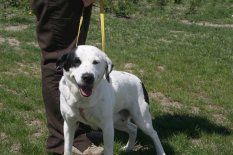

One of my mother's favorite television shows is The Dog Whisperer, a National Geographic Channel program starring the dog behaviorist Cesar Millan and many ill-behaved pooches of all breeds. After watching the show with her for the second time, I rolled my eyes and said, "Mom, this isn't about messed up dogs, it’s about messed up people!"
Okay, two shows does not a fair assessment make, but from what I could see, there are more than a few people out there encouraging poor habits in their dogs. There was man who let his dog sleep on the sofa, but then was embarrassed when the Doberman refused to get down when guests visited. Or the dog that tore up newspaper and magazines in a frenzy, clearly finding its owner’s high-pitched, nervous reprimands as an overture for play. Most disturbing, was the woman who laughed nervously when her dog growled and nipped at her son! In too many cases, the dog was the one in control - not the person, much like a petulant toddler who wails and connives until getting his way.
While there are a few important, but simple, things to keep in mind when trying to train or retrain your dog, probably the most important thing to keep in mind is that you may have to retrain yourself first.
Assume the Leader-of-the-Pack Role
Dog trainers agree that the first thing to understand in establishing good habits in your dog is that dogs operate in a pack mentality. Descendents of wolves, they operate in a group and have one of two roles: leader or follower. In a human household, the human is the leader, the dog is the follower. No other arrangement will work in the long run. It's your responsibility to be in control and provide clear guidance to your dog in a calm, non-threatening manner. We've all heard a person yell, "No! No! No!" at a barking dog, and we've all heard the dog continue to bark. And yet, the person doesn't stop to think, "Hmmm, this isn't working" People, it turns out, aren't very good at retraining themselves.
Prepare Yourself to Spend Time Training
Having a dog means providing a certain level of time and energy to it, especially to provide much needed exercise. In its earliest weeks - even years - in your house, it takes especially focused time to teach the dog good behavior. As I consider whether my family will get another pooch when my dog Hannah passes away, I keep this in mind: Do I have the energy and attention it would require to train a new member of our pack? Last year, when I got my first cat, I was amazed by the way it came home, looked around, discovered its food and litter box and that was pretty much that. What about the nights of whining in the kitchen? The weeks of toilet training? The nipping and pulling on the leash? I'd done all of that with Hannah and the end result was a dog that understood the rules and has been a gentle companion for my kids and me. She's a gem, but not by chance.
Nip Bad Behavior in the Bud ... Now
Most dog trainers agree that a good human pack leader will actively discourage the following habits and replace them with those that follow:
It's harder to teach an old dog new tricks for certain, but it's hardly impossible. Miriam Smith, a high school freshman in Indiana, got an adult dog from the animal shelter following the death of her family's golden retriever. She quickly discovered that Harley wasn't quite as well trained as her old friend. "Harley would pounce all over my friends whenever they came over and scare them. No one wanted to come to my house any more, so that was a problem."
Miriam and her mom worked with a trainer to put Harley in a down, or submissive, position in another part of the house when someone came to the door. It became a rote behavior: a new person enters the house and Harley goes to his pillow in the corner. Through a series of reprimands and/or affection, based on Harley's behavior, they were able to retrain him in a few months. "Now, Harley is everyone's best friend" says Miriam, pleased not only with her dog but also with her ability to teach him good behavior.
My dog is quite elderly now, and her bad habits rarely extend far from her king-sized dog bed, but I remember the days when it was hard to be Alpha to her adorable insouciance. Just as I sometimes have to work to keep a straight face while disciplining my five-year-old son because he’s just so dang cute, I had to force myself to provide tough love to my dog. But it was worth it. If you're feeling soft, consider whether a dog's present behavior is going to be so cute once he's older or, in some cases, much bigger. A puppy that jumps up on you is one thing; an eighty-pound lab that jumps on you is another.
_________________
By Jennifer New for DivineCaroline.com (View Profile)
Copyright © 2005-2016 Pet Information All Rights Reserved
Contact us: www162date@outlook.com